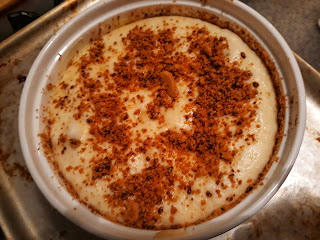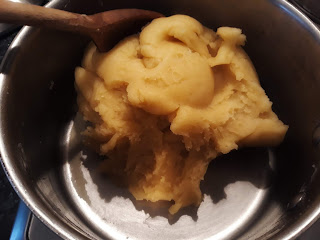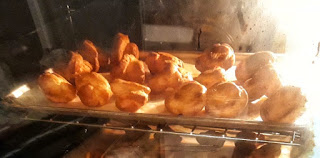However, it is easy to forget what a delicious and versatile
fruit the pear can be; especially when aromatic and very ripe, its optimum
state according to the late, great broadcaster Terry Wogan
who said it had to be so ripe and messy that the only way to eat one was hovering
over the sink completely naked.
A ripe pear is a gastronomic delight. And one rarely
experienced by those who buy their fruit in packets at the supermarket,
following the ‘best before’ dates to the letter. If you have a large, ripe pear,
leave it in the fruit bowl as long as you dare, you won’t be disappointed. If
you need to feed several people, use it to make a soufflé like this one.
The peariness can be enhanced – should you like – with some
pear brandy. This can come in the form of a calvados that uses perry (pear
cider) in its manufacture, or the liqueur Poire William. These can be tricky to
get hold of, so you could go with the cherry liqueur, Kirsch.
By the way, this is the last of two sweet soufflés
from the book (the other being #293
Mrs Beeton’s Chocolate Soufflé), and the last of the entire book (there are several soufflé
recipes in the book). Not only that, it the last of the recipes in the
behemoth that is the Puddings
chapter of the book!
First of all, preheat your oven to 200°C,
and prepare your soufflé dish: Take two macarons
and crush them. A good macaron should be squidgy in the middle, so I found
this task much easier by freezing them and blitzing them in my food processor. Next,
butter the dish well – you’ll need
one around 2 ½ pints (1.5 litres) capacity for this recipe. Sprinkle the
macaron dust all around the inside of the buttered dish, saving the remaining crumbs
for later (see below).
Take a large, ripe pear
and peel, core and quarter it. Take a fork and give it a mashing, or if feeling
lazy, use a food processor or hand blender. My pear was so ripe that it started
to brown almost immediately, stymie this by quickly adding the juice of half a lemon along with a tablespoon of
the pear brandy (or Poire William, or Kirsch).
Place 4 ounces of butter
in a mixing bowl and let it melt slowly over a pan of just simmering water. As
you wait, measure out 4 ounces of vanilla
sugar (posts #36 Vanilla Sugar and #266
Concentrated Vanilla Sugar
show you how) and 1 ounce of cornflour.
When the butter has melted, sift these into it and beat in well with a whisk.
Separate four eggs,
take the bowl off the heat and beat the yolks in one-by-one, then add the pear
mixture. Whisk the whites to the stiff peak stage (when you can turn the bowl
upside down and the whites stay firmly put). Add a large tablespoon of the whites
to the mixture and mix in well, don’t worry about losing any air at this stage,
adding a little egg white now means that the rest will be ‘accepted’ by the
mixture more readily.
Tip in the rest of the egg white, fold it into the pear
mixture with a metal spoon. I found that the mixture was too runny to mix the
whole lot together well – I presume I didn’t let the cornflour thicken enough.
Pour the mixture into the soufflé dish, sprinkle with the remaining
macron crumbs and put in the oven.
After 3 minutes, turn down the heat to 190°C and cook for another 27 minutes (i.e. half an hour in all).
After 3 minutes, turn down the heat to 190°C and cook for another 27 minutes (i.e. half an hour in all).
#436 Worcestershire
Pear Soufflé. I’m not sure what to
make of this recipe – it tasted delicious, the overripe pear, alcohol and hint
of vanilla made for quite a heady aromatic hit, but the texture was a little
wrong; the mixture essentially sank to the bottom, not getting incorporated
properly, and remained very liquid. I know that a good soufflé
should be light at the top and saucy in the centre, but here the contrast was a
bit too much. I think that Jane’s instructions were not clear enough regarding
the base mixture – perhaps the butter-sugar-cornflour mixture should have been
cooked until very thick before adding the rest of the ingredients. I think that
this is worth trying again to get right as it should have been an excellent
pud. In conclusion, flavour excellent, but recipe perhaps too vague: 7/10
















